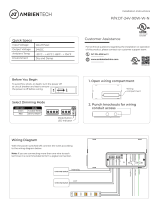
WIRELESS CONFIGURATION SETUP INSTRUCTIONS
• When you see in the instructions, press the top of the
paddle on the Miro device.
• When you see in the instructions, press the bottom of the
paddle on the Miro device.
• When you see
in the instructions, simultaneously press and
hold BOTH the top and bottom of the device paddle.
SET HOUSE ID
All Miro wireless devices installed in the same system must
acquire the same House ID before use. This process is known as
house binding. Each Miro wireless device is bound to all other
Miro wireless devices in the house.
New Installation
1. With all devices installed and energized, make sure that every
Miro wireless device LED is yellow. If any LED is off, be sure
the circuit breaker is on and the device is correctly installed.
2. Press on any device paddle until the
LED flashes yellow (about 2 seconds).
This indicates that it has acquired a
unique House ID.
3. Make sure that all other Miro wireless
device LEDs are flashing green,
indicating that they have acquired the
same House ID.
4. Return to the device used in step 2, which is still flashing
yellow. Press until the LED changes to solid green (about 2
seconds).
All device LEDs in the house change to solid green, indicating
house binding is complete.
Adding a DRLV1 to an Existing Installation
If you’re adding or replacing a DRLV1 in a Miro wireless
installation that is already operating, the new DRLV1 must
acquire the same House ID as the other Miro wireless devices
already in the house. After the DRLV1 is powered up, the LED
should be solid yellow. This indicates that it has not yet acquired
a House ID. To acquire the House ID for the existing system:
1. Press on any previously bound device
until the LED flashes yellow (about 2
seconds).
2. Verify that the newly added DRLV1’s LED
begins flashing green, indicating that it
has acquired the House ID.
3. Return to the same device used in step
1 and press until the LED changes to
solid green (about 2 seconds).
All device LEDs should now be solid green.
ADVANCED WIRELESS OPERATION
Groups
You can use a DRLV1 in conjunction with one or more Miro DRD8
Wireless Multilocation Controllers to control one circuit from
multiple locations. Binding the DRLV1 and DRD8 devices together
in the same Group enables them to work in exactly the same way,
from any of the control locations.
You can include other Miro wireless devices in the Group. Just
remember that all devices in the Group operate when one
member operates.
Set the House ID (see Set House ID) before setting up Groups.
Set up Groups before setting up Scenes.
Creating a New Group
1. Go to any device that you want to include in the Group. Press
. The device LED flashes yellow, and all other devices in the
house flash green.
You now have 5 minutes to complete this process.
2. To include or exclude a device in the Group press on the
device until the LED changes color.
Yellow flashing LED = Included in the Group
Green flashing LED = NOT included in the Group
If you get to a device and it is NOT flashing, the 5 minute
binding process timer may have expired. Go back to step 1
and repeat.
3. Return to the device used in step 1 and press to terminate
Group binding. All LEDs revert to solid green. Now, all the
devices in the Group control their load circuit in exactly the
same manner.
Adding a DRLV1 to a Group in an Existing System
1. Go to a device that is in the Group where you want to add the
dimmer.
Press .
The device LED and all members of the Group flash yellow.
The new DRLV1 flashes green.
2. Press on the new dimmer until its LED flashes yellow.
3. Return to the device used in step 1 and press .
All LEDs are solid green.
Scene Control
The DRLV1 may be easily incorporated into room and whole
house preset scenes. The Miro Installation Guide provides more
information about configuring scenes and presets.
Instructions for installation and use are included with the
relevant Miro wireless room and whole house control devices.
Application support information and the Miro Installation Guide
are available online.
page 5









